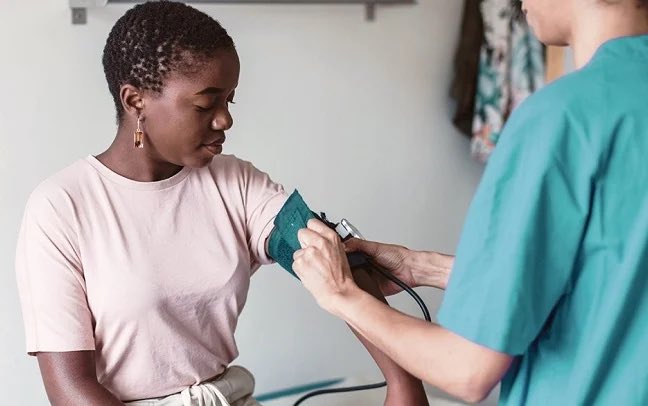A recent study has found that a wrong arm position during blood pressure (BP) checks may lead to misdiagnosis and overestimation of hypertension.
BP is the pressure of circulating blood against the walls of blood vessels. It is measured in units of millimeters of mercury (mmHg). The reading consists of two numbers — with the upper (systolic) value first, followed by the lower (diastolic) value. A person is considered hypertensive if they have consistent readings of 130/80 or higher.
The new study, published on Monday in Journal JAMA Internal Medicine, analysed the blood pressure readings of 133 adults from August 2022 to June 2023. The study volunteers’ ages ranged from 18 to 80.
The blood pressure readings were measured and compared while the people held their arms in three different ways — leaning on a surface, resting on the lap, or hanging by the side of the body.
The researchers from Johns Hopkins University discovered that when participants had their arms hanging by their sides during the reading, their systolic pressure was 6.5 points higher than when their arms were resting on a desk, while the diastolic blood pressure — the bottom number — was 4.4 points higher than in the supported condition.
The experts also found out that when their arms were on their laps, the systolic blood pressure was 3.9 points higher than when their arms were supported by a surface, while the diastolic pressure was 4 points higher than in the supported condition.
For example, if a person’s actual blood pressure is 134, and blood pressure is measured on a dangling arm, the reading could end up over 140, which is considered to be stage 2 hypertension.
Tammy Brady, the vice-chair for clinical research in the department of pediatrics at the Johns Hopkins University School of Medicine, said the two other positions were tested because it was realised that they are the most used positions during blood pressure readings.
“I did not expect there to be that much of a difference when the arms were placed in the two alternative positions,” he said.
“We tested those positions because those are the positions that most people have their blood pressure measured, according to data and personal observations.
“We thought there’d be a difference, but I was surprised by how much of a difference there was.”
According to the study, the wrong positioning of the arm during BP readings leads to overestimation due to several physiological reasons.
First, there can be muscle contraction when the arm is not supported which can lead to an increase in BP reading.
Also, a greater vertical distance between the heart and where the cuff is placed can increase hydrostatic pressure in the arteries, or the blood pressure against the wall due to gravity’s pull. This can lead to an overestimation of blood pressure.
Brandy said the study was conducted to educate people on the appropriate arm position for BP reading.
“I just hope that it raises awareness regarding how important things like arm position are to blood pressure measurement accuracy,” he added.
“I also hope this study educates patients, empowering them to advocate for proper measurement when they’re in a clinic setting.
“But also, because so many patients rely on home blood pressure measurements for hypertension diagnosis, evaluation, and treatment.
“I hope this educates them on how to properly position their arms because our findings absolutely extend to measurements in the home.”
The researchers also gave the following steps to achieve an accurate BP measurement.
The steps include:
Wear the appropriate cuff size
Have your back supported
Keep feet flat on the floor with legs uncrossed
Have the appropriate arm position – the cuff should be positioned at heart level with the arm supported on a desk or table
Wearing the appropriate cuff size was found to be the most important step.
Because an improperly sized blood pressure cuff can distort blood pressure readings taken by automated blood pressure devices.
Also speaking, Gail Adler, a cardiovascular endocrinologist in the Hypertension Clinic at Brigham and Women’s Hospital, disclosed some steps that should taken 30 minutes for BP measurement.
“Before you take your blood pressure, you want no smoking, exercise, caffeine, alcohol, major arguments. Don’t be psychologically stressed,” Adler said.
“Sit in the chair, get in the right position. And for five minutes, you relax, you don’t talk, make sure you don’t have to pee. If you have to pee or urinate, that’s going to raise your blood pressure.”




